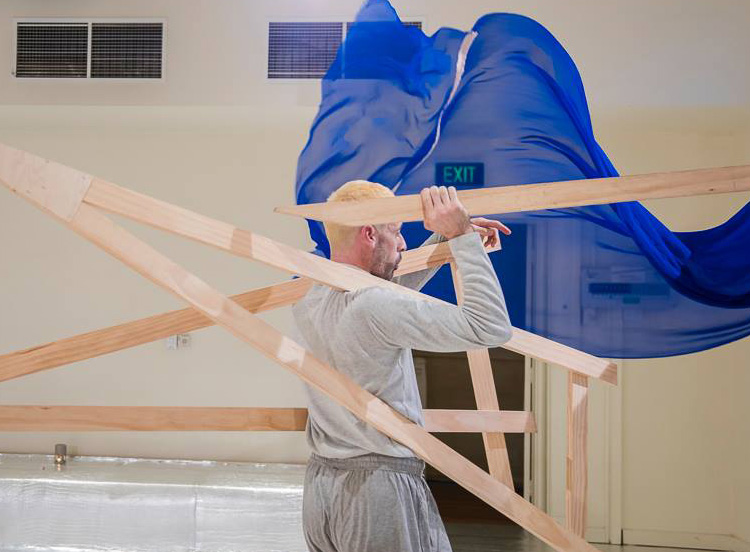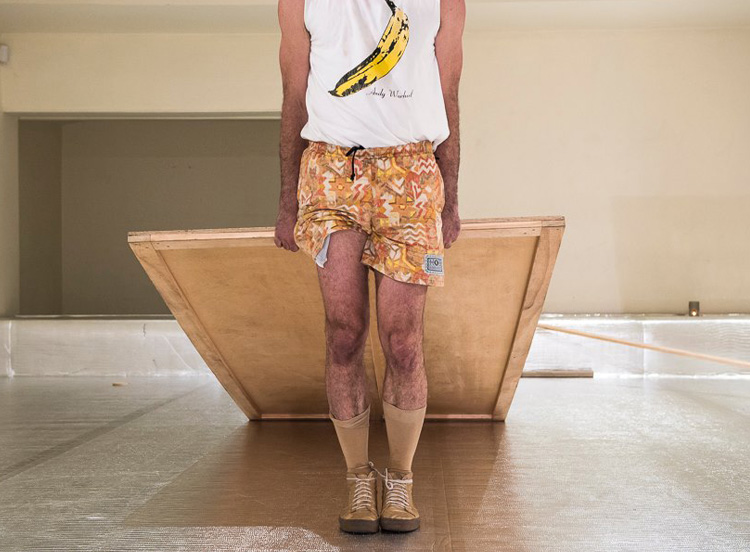The process of making

Assemblage #1
Saturday 26th November, 2016
Upstairs Studio, Dancehouse
Concept and Performance: Matthew Day
Sound: James Brown
Collaborators: Tim Darbyshire, Martin del Amo
Fabrication, my response to Tremor, drawn up especially for Fjord Review.
Any time between 3pm and 6pm. That was the deal. Any time within a window. And with freedom to explore. Come and go, as you please. The doors will be left open. Take photos, should you choose. Inhabit the space as you would a public area. Like a park, say. Be a living part of an assemblage. Move within the space. Walk through to the library. Squat beneath the window, recline on the slope, lean against the wall, perch on the ledge just inside the door: it’s up to you. Come, stay, and go, as you please, the invitation stood.
When only recently I thought how I would like to have experienced Ashley Dyer’s Tremor (at Arts House) as a durational piece, with the chance to select my own vantage, here was my chance to experience a new work by Dancehouse artist-in-residence, Matthew Day. Assemblage #1 was my chance to encounter dance as I do art, to treat the performance as I would a painting, installation, sculpture, readymade, or a Fluxus box of matches.[i] And yet rather unsurprisingly, I conformed to theatre standards.
I arrived just before 3pm. I arrived for the start of a work with no real start. And I was not alone. In the foyer on a quiet Saturday afternoon, a small knot of people waited for the dance to begin. As I collected my tickets from the box office/bar, Day was at the sink getting a glass of water. Upon seeing the waiting spectators, I wondered if he was disappointed by our collective missed opportunity to enter a theatre-cum-gallery and wonder: what did I miss? What happened before? Has the dancer been here all day? Will the dancer leave? Is this art? Is this dance? Is there a difference? And does it matter?
A casual glance at my watch, it was after 3pm. The work had begun, hadn’t it? Making my way upstairs, I lingered on the landing by the ladder and sheets of timber propped against the wall. Wasn’t it Agatha Christie’s Poirot who ruminated about the landing being the place to pause expectantly and survey? I entered and stood by the window just inside the door. The studio was a silvered beauty, its floor completely covered by sheets of insulation. Dotted about the landscape, several plastic drink bottles, more timber panels, swathes of fabric from the overhead beams, and two bunches of bananas.
As Day walked towards where I was standing, following a line in the insulation, I sidestepped out of his way. I perched on the ledge inside the door, by the usher, and those that entered the space behind me followed suit. Together, unintentionally, we made the ledge into a bank of seats. By sitting in a row, we, the audience, said ‘this is the foot of the stage.’ Day asked us to disperse ourselves throughout the space; there was no stage. The polite implication being that for that kind of uniformity you could have come to one of the 50-minute performances with neat start and close rules of familiarity.
I sat over by the wall with a view of the windows. To my left, a drink bottle, three-quarters-full. Before me, two large flat sheets of timber and a bunch of ripe bananas. To my right, a swathe of sheer patchwork drapery pegged up like a makeshift cubby or change room’s modesty screen. The arrangement had all the hallmarks of an animal enclosure meets art exhibition installation. Nearby, a Makita drill stood upright as though the technician had just left the gallery to get a new drill bit. But who would get to the fruit first, the unseen animal or the technician?
The remainder of the ‘3pm-starters’ propped against the walls, and two reclined on the slope in classic picnic pose. We were now randomly dispersed and visible within the work; a loose assemblage of diverse parts that meshed together. We may have needed a little encouragement about how to be within the space, but we got there in the end. (Note to self: read and digest the programme notes beforehand. Note to reader: incidentally, those who arrived after 3pm all made a beeline for the same safe ledge.) Removing the front of the stage, we all had different views. Removing the front of the stage, there was a palpable sense of ‘will there be audience participation’ or was that just me?
Slowly, Day picked up a long piece of sheer cobalt blue fabric. He studied it as if he had not encountered it before. He dropped it to the ground. He picked it up again in the manner of ‘what enrichment tool has the Keeper left for me to engage with?’ And in this pick-up-drop, pick-up-drop routine, Day made his way over to where I sat. Pick-up-drop, pick-up-drop, up and over my knees, and up and over my head. For a moment, my face revealed, I was a veiled lady, a Madonna in blue, before Day continued to pick-up-drop, pick-up-drop.
Just as a stage can be made and consequently taken away, the same applies to materials. Unfixed, they can become anything, and it was this notion of play and reinterpretation that I most responded to in Assemblage #1. I never thought I’d be the Madonna, just as, I suspect, the man leaning against the wall opposite me didn’t expect his open bag to become a vessel for Day’s discarded black garb. Day later appropriated the use of two pieces of timber and fashioned for himself a pair of snowshoes. He slid through the space like Manny and his childhood breezeblock recollections in an episode of Black Books. With the same (or was it another? It need not matter) piece of timber he made a military standard and raised the bananas above his head. My temporary veil reinvented as a flowing cloak fastened about Day’s shoulders. This was about what Day describes as “a commitment to the now. A now that moves in many directions all at once.”[ii] One, two, three, Day plopped three Beroccas into one of the bottles dotted about the room, changing the water from clear to orange fizz. Changing the landscape before my eyes with the plainest of means and humour.
With objects unhooked from their expected role, as Day climbed up the ladder and draped the blue cloth from the exposed ceiling beam, I was reminded of recently watching the RMIT School of Art students as they installed their graduate exhibition. To me, the focus of the installation process is beautiful, both as spectator (outside) and artist (within). And it is fleeting. And for a moment, Day brought this back to me. This moment during install is sacrosanct and quiet, as a work is in flux. Through his durational piece, Day explored time and his languid gestures appeared to extend time, or, at least, my perception of time. As Dancehouse’s artistic director, Anna Conquet explained, “there is a visceral letting go in Assemblage #1, a sort of poetic absence while ‘doing,’ a body in space and time, surrounded by concrete objects as a shield against the expanding immateriality of our lives.”[iii]
Throughout the work, costume changes formed new skins. Just as timber slats could become snowshoes, so too, a pair of thin grey tracksuit pants could be worn inside out and pulled up past the navel to make a high-waisted silhouette. Add a collection of screws to the pocket and jangle them through movement, and you’ve made an instrument that your body will never be out of time with.
Much like Fluxus, the focus felt as though it was about the process of making, and giving space to the ideas chance throws up, rather than about the end piece. Here was a work without an end, the DeLanda ‘process not product’ of Assemblage Theory. Day’s Assemblage #1 strove to make manifest, and have fun with, the written definition of assemblage: “it is a multiplicity which is made up of many heterogeneous terms and which establishes liaisons, relations between them, across ages, sexes and reigns — different natures. Thus, the assemblage’s only unity is that of a co-functioning: it is a symbiosis, a ‘sympathy.’”[iv] And so I left as a bunch of bananas swung from a chord hanging from above. There should be no end. There was no end. The bananas still swing. Free.
[i] Ben Vautier, Total Art Matchbox from Flux Year Box 2. c. 1968, Fluxus Edition unannounced, MOMA, accessed November, 2016.
[ii] Matthew Day, Assemblage #1, Work in Development, Accomplice, accessed November, 2016.
[iii] ‘Matthew Day to premiere Assemblage #1,’ Anna Conquet cited by Dance Informa, accessed November, 2016.
[iv] Deleuze and Parnet, Dialogues II, p. 69, cited by Manuel DeLanda in the Introduction to Assemblage Theory (Edinburgh: Edinburgh University Press, 2016), p. 1, accessed November, 2016.
Image credit: Joseph Beuys, Sulphur-Covered Zinc Box (Plugged Corner), 1970, multiple, published by Edition Tangente, Heidelberg (Harvard Art Museums)


